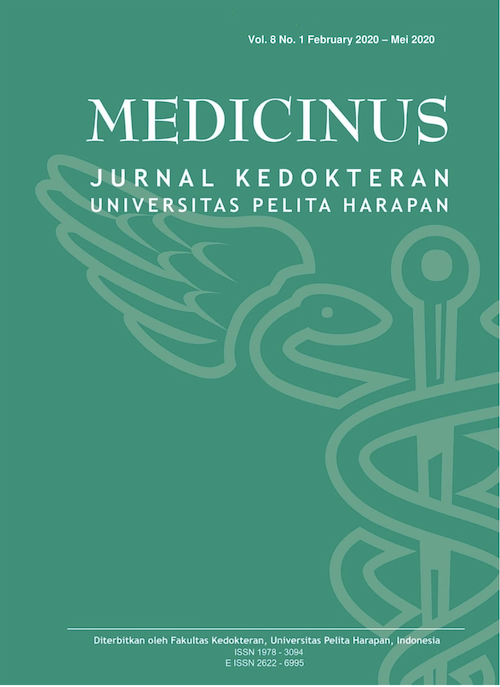The Effect of Light Colour During Night Time to Sleep Quality
DOI:
https://doi.org/10.19166/med.v8i1.3123Keywords:
light color, sleep qualityAbstract
Introduction: Sleep is one of the basic human needs, where human uses one third of their time only for sleeping. Some contributing factors towards bad sleep quality are stress, depression, surrounding noise, and the use of a bright light. It is known that white lights cause the activation of melanopsin, causing circadian cycle shift, whereas using yellow light does not. The aim of this research was to analyze whether there is an effect of using either white or yellow light towards sleep quality
Method: This is RCT on 81 subjects. Sleep quality was measured using PSQI questionnaire on 3 measurements with each measurement taken every week. Result of the analyzed data using the General Linear Model - Repeated Measurement (GLM-RM) method
Result: There were significant differences on PSQI score between group that used white light during sleep (7.6 ± 2.3) in comparison to the control group (5.2 ± 1.8) (p = 0.02), but result also showed that there were no significant difference between the group that used yellow light (6.1 ± 1.7) during sleep in comparison with the control group (p = 0.14). Conclusion: There is a significant difference between the uses of white lights during sleep towards sleep quality, but there has not been any significant difference between the uses of yellow light during sleep towards sleep quality
References
1. McLeod S. Maslow’s Hierarchy of Needs Simply Psychology.
2. Heart N, Institute B, Institutes of Health N, Department of Health U, Services H. Your Guide to Healthy Sleep.
3. Lemma S, Berhane Y, Worku A, Gelaye B, Williams MA. Good quality sleep is associated with better academic performance among university students in Ethiopia. Sleep Breath. NIH Public Access;18(2):257-63.
https://doi.org/10.1007/s11325-013-0874-8
4. Luo J, Zhu G, Zhao Q, Guo Q, Meng H, Hong Z, et al. Prevalence and risk factors of poor sleep quality amo ng Chinese elderly in an urban community: results from the Shanghai aging study. PLoS One. Public Library of Science; 2013;8(11):e81261.
https://doi.org/10.1371/journal.pone.0081261
5. Haryono A, Rindiarti A, Arianti A, Pawitri A, Ushuluddin A, Setiawati A, et al. Prevalensi Gangguan Tidur pada Remaja Usia 12-15 Tahun di Sekolah Lanjutan Tingkat Pertama. Sari Pediatr.;11(3):149.
https://doi.org/10.14238/sp11.3.2009.149-54
6. Altun I, Cınar N, Dede C. The contributing factors to poor sleep experiences in according to the university students: A cross-sectional study. J Res Med Sci.;(6):557-61.
7. Dobing S, Frolova N, McAlister F, Ringrose J. Sleep Quality & Factors Influencing Self-Reported Sleep Duration and Quality in the General Internal Medicine Inpatient Population. Eckle T, editor. PLoS One. Public Lib of Sci;11(6):e0156735.
https://doi.org/10.1371/journal.pone.0156735
8. Tosini G, Ferguson I, Tsubota K. Effects of blue light on the circadian system and eye physiology. Mol Vis. Emory Univ; 2016;22:61-72.
9. Kurt S, Osueke KK. The Effects of Color on the Moods of College Students. SAGE Open. SAGE PublicationsSage CA: Los Angeles, CA;4(1):215824401452542.
https://doi.org/10.1177/2158244014525423
10. Hatori M, Gronfier C, Van Gelder RN, Bernstein PS, Carreras J, Panda S, et al. Global rise of potential health hazards caused by blue light-induced circadian disruption in modern aging societies. NPJ aging Mech Dis. Nature Group; 2017;3:9.
https://doi.org/10.1038/s41514-017-0010-2
11. Welsh DK, Takahashi JS, Kay SA. Suprachiasmatic nucleus: cell autonomy and network properties. Annu Rev Physiol. NIH Public Access;72:551-77.
https://doi.org/10.1146/annurev-physiol-021909-135919
12. Lee S, Kim D. Effect of Color Light Stimulation Using LED on Sleep Induction Time. J Health Eng.; 2017;2017:6030268.
https://doi.org/10.1155/2017/6030268
Downloads
Published
How to Cite
Issue
Section
License
Copyright (c) 2021 Peter Sylvanus, Nicolaski Lumbuun

This work is licensed under a Creative Commons Attribution-ShareAlike 4.0 International License.
Authors who publish with this journal agree to the following terms:
1) Authors retain copyright and grant the journal right of first publication with the work simultaneously licensed under a Creative Commons Attribution License (CC-BY-SA 4.0) that allows others to share the work with an acknowledgement of the work's authorship and initial publication in this journal.
2) Authors are able to enter into separate, additional contractual arrangements for the non-exclusive distribution of the journal's published version of the work (e.g., post it to an institutional repository or publish it in a book), with an acknowledgement of its initial publication in this journal.
3) Authors are permitted and encouraged to post their work online (e.g., in institutional repositories or on their website). The final published PDF should be used and bibliographic details that credit the publication in this journal should be included.





